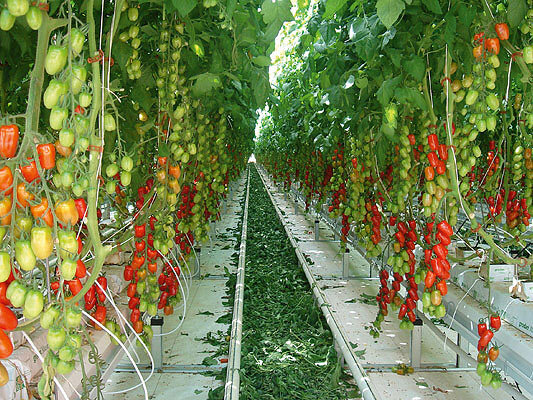Better quality and a more pleasant working climate
After a trial in which half a roof was covered with ReduFuse, Kainz & Mayer Marchfeld tomatoes, has switched over to using it completely. Cluster quality and setting improved and some varieties yield more too.
The nursery in Obersiebenbrunn (Lower Austria) grows middle-sized cluster tomatoes and cocktail tomatoes in 9 hectares of glasshouses. “If we don’t use a coating we have to close the screens to lower the excessive light and heat. Then we quickly end up with a stuffy climate. As a result we can’t close the screen over the whole greenhouse; we have to leave a quarter of it open,” says co-owner, Thomas Kainz.

In 2013 they carried out a trial with ReduFuse. In one trellis they applied the coating above six rows but only on the south side. The north side was not covered. “That produced too many problems in the summer,” says Kainz. “The sun is then too high and shines on the crop via the north side. So in 2014 we covered the whole roof using 13 buckets per hectare. It was applied during the first week in April and removed in August. The haze factor was about 60%.”
They determine the timing for application and removal based on the quantity of light, the state of the crop and the weather forecasts.
The grower is pleased with the effect of the coating: “In 2014 we had no blossom end rot apart from one or two fruits next to the path. It’s mostly the varieties Annamay and Bonaparte that suffer problems during the hot Austrian summer. Under ReduFuse this doesn’t happen which results in a higher yield. With the less sensitive varieties – Cappricia and Brioso – we hardly saw any increase in yield. In general, cluster quality and setting improved.”
A disadvantage of this coating is that during the summer it only provides for 10% shading. For circumstances in Lower Austria, this is actually too little.
Therefore powdered chalk is also applied to the roof during the summer. “The result is that we have not used the inner screen at all during the summer. We did close it in the spring and autumn to save energy.”
Due to different climate conditions under ReduFuse, Kainz noticed that he had to adjust the method of cultivation. The crop became more vegetative. That is an advantage in the summer, because then the dry hot weather strongly stimulates generative growth. In April that is not the case, but then the increasing light intensity makes it easier to steer generatively, says the grower. The coating makes it possible to ventilate less. That is an advantage for maintaining the target level of CO2 in the greenhouse, which is 500 ppm. Kainz finds a drop below 400 ppm unacceptable, so then he doses with technical CO2.
This year the nursery is continuing in the same way so it is using ReduFuse again in the same quantity. “It hardly causes any loss of light in the spring and autumn and it stimulates the plant. In addition, it is more pleasant for our staff to work under a diffuse coating.”